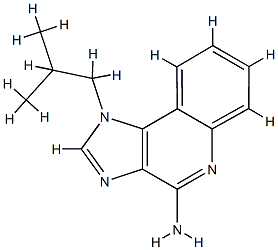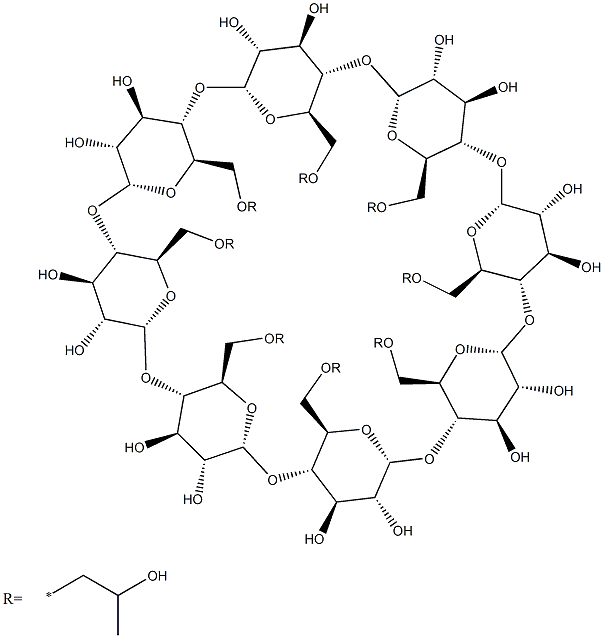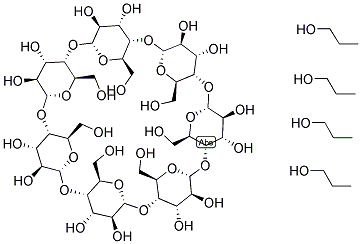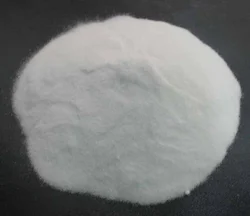Hydroxypropyl methyl cellulose
Synonym(s):(Hydroxypropyl)methyl cellulose;Hydroxypropylmethylcellulose 2910
- CAS NO.:9004-65-3
- Empirical Formula: C3H7O*
- Molecular Weight: 59.08708
- MDL number: MFCD00131360
- EINECS: 618-389-6
- SAFETY DATA SHEET (SDS)
- Update Date: 2025-12-17 09:49:38

What is Hydroxypropyl methyl cellulose?
Toxicity
LD 50 (Rat): > 5 g/kg .
Hypromellose is considered low toxicity to non-toxic .
Adverse events may include blurred vision and contact dermatitis . Hypersensitivity and intolerance reactions may occur (for example, eye burning, pain, increased lacrimation, a sensation of foreign body, conjunctival hyperemia, eyelid swelling, pruritus). The stickiness sensation of the eyelids, the decreased sense of smell, photosensitivity .
Chemical properties
Hypromellose is an odorless and tasteless, white or creamy-white fibrous or granular powder. This product is soluble in water (10 mg/ml). However, it is very important to thoroughly disperse the particles in water with agitation before they will dissolve. Otherwise, they will lump and form a gelatinous membrane around the internal particles, preventing them from wetting completely. There are four dispersion techniques commonly used to prepare solutions of hydroxypropylmethylcellulose: dispersion in hot water, dry blending, dispersion in non-solvent medium, and dispersion of surface-treated powders.
The Uses of Hydroxypropyl methyl cellulose
Hydroxypropyl Methylcellulose is a gum formed by the reaction of propylene oxide and methyl chloride with alkali cellulose. it will gel as the temperature is increased in heating and upon cooling will liquefy. the gel temperature ranges from 60°c to 90°c, forming semifirm to mushy gels. it is used in bakery goods, dressings, breaded foods, and salad dressing mix for syneresis control, texture, and to provide hot viscosity. usage level ranges from 0.05 to 1.0%.
Background
Hypromellose, or hydroxypropyl methylcellulose (HPMC) , is a semisynthetic, inert, and viscoelastic polymer that forms a colloid solution when dissolved in water. It acts as a thickening agent, coating polymer, bioadhesive, solubility enhancer in solid dispersions, and binder in the process of granulation and in modified release formulations . It is a commonly used as a delivery component in oral pharmaceutical products that provides the release of a drug in a controlled fashion, effectively increasing the duration of release of a drug to prolong its therapeutic effects . Hypromellose is also found in eye drops as a lubricant .
Production Methods
A purified form of cellulose, obtained from cotton linters or wood pulp, is reacted with sodium hydroxide solution to produce a swollen alkali cellulose that is chemically more reactive than untreated cellulose. The alkali cellulose is then treated with chloromethane and propylene oxide to produce methyl hydroxypropyl ethers of cellulose. The fibrous reaction product is then purified and ground to a fine, uniform powder or granules. Hypromellose can then be exposed to anhydrous hydrogen chloride to induce depolymerization, thus producing low viscosity grades.
What are the applications of Application
Hydroxypropyl methyl cellulose is used as an ophthalmic lubricant, an emulsifier and a thickening and suspending agent. It is widely used as an excipient in pharmaceutical formulations. It acts as a food additive. Its eye drops are known as artificial tears, which are used to relieve eye dryness and soreness. It finds applications in various fields as emulsifier, film former, protective colloid, stabilizer, suspending agent, or thickener in foods. Pharmaceutic aid (suspending agent; tablet excipient; demulcent; viscosity increasing agent); hydrophilic carrier in drug delivery systems. In adhesives, asphalt emulsions, caulking compounds, tile mortars, plastic mixes, cements, paints.
Indications
Hydroxypropyl methylcellulose belongs to the group of medicines known as artificial tears. It is used to relieve dryness and irritation caused by reduced tear flow. It helps prevent damage to the eye in certain eye diseases. Hydroxypropyl methylcellulose may also be used to moisten hard contact lenses and artificial eyes. In addition, it may be used in certain eye examinations.
General Description
Hydroxypropylmethylcelluloses are water soluble polymers derived from cellulose. They are typically used as thickeners, binders, film formers, and water retention agents. They also function as suspension aids, surfactants, lubricants, protective colloids, and emulsifiers. In addition, solutions of these polymers thermally gel.
These polymers are prepared by reacting wood or cotton cellulose fibers with propylene oxide and methyl chloride in the presence of caustic soda. This product has a methoxyl content of 28-30% and a hydroxypropoxyl content of 7-12%.
Pharmacokinetics
Hypromellose is the most commonly used in hydrophilic matrix fabrication. It allows for controlled release of drug substances, increasing duration of therapeutic effects . The physical characteristics of this drug resemble natural tears, providing lubrication to the ocular surface and maintaining corneal hydration in dry eye syndromes.
Side Effects
Even though it may be rare, some people may have very bad and sometimes deadly side effects when taking a drug.
Major & minor side effects for Hydroxypropyl Methylcellulose
Blurred vision
Decrease/loss of vision
Eye pain
Excessive tearing of the eye
Redness in and around the eyes
Safety
Hypromellose is widely used as an excipient in oral, opthalmic,
nasal, and topical pharmaceutical formulations. It is also used
extensively in cosmetics and food products.
Hypromellose is generally regarded as a nontoxic and nonirritating
material, although excessive oral consumption may have a
laxative effect. The WHO has not specified an acceptable daily
intake for hypromellose since the levels consumed were not
considered to represent a hazard to health. In fact, high dosages
of hypromellose are being investigated for treating various
metabolic syndromes.
LD50 (mouse, IP): 5 g/kg(20)
LD50 (rat, IP): 5.2 g/kg
Structure
Hydroxypropyl methyl cellulose (HPMC) is a propylene glycol ether of methylcellulose. In this compound, hydroxypropyl and methyl groups are attached to the anhydrous glucose rings of cellulose through ether linkages. HPMC is synthesized from methyl cellulose through the reaction with alkali and propylene oxide. This process produces a water-soluble ether derivative of cellulose that contains both methoxy and hydroxypropyl groups. The degree of substitution for HPMC ranges from 1.08 to 1.83, with hydroxypropyl groups being the minor constituent.
Storage
Hypromellose powder is a stable material, although it is hygroscopic
after drying.
Solutions are stable at pH 3–11. Hypromellose undergoes a
reversible sol–gel transformation upon heating and cooling,
respectively. The gelation temperature is 50–90°C, depending
upon the grade and concentration of material. For temperatures
below the gelation temperature, viscosity of the solution decreases
as temperature is increased. Beyond the gelation temperature,
viscosity increases as temperature is increased.
Aqueous solutions are comparatively enzyme-resistant, providing
good viscosity stability during long-term storage. However,
aqueous solutions are liable to microbial spoilage and should be
preserved with an antimicrobial preservative: when hypromellose is
used as a viscosity-increasing agent in ophthalmic solutions,
benzalkonium chloride is commonly used as the preservative.
Aqueous solutions may also be sterilized by autoclaving; the
coagulated polymer must be redispersed on cooling by shaking.
Hypromellose powder should be stored in a well-closed
container, in a cool, dry place.
Incompatibilities
Hypromellose is incompatible with some oxidizing agents. Since it is nonionic, hypromellose will not complex with metallic salts or ionic organics to form insoluble precipitates.
Regulatory Status
GRAS listed. Accepted for use as a food additive in Europe. Included in the FDA Inactive Ingredients Database (ophthalmic and nasal preparations; oral capsules, suspensions, syrups, and tablets;topical and vaginal preparations). Included in nonparenteral medicines licensed in the UK. Included in the Canadian List of Acceptable Non-medicinal Ingredients.
Properties of Hydroxypropyl methyl cellulose
| Melting point: | 225-230 °C |
| Density | 1.39 |
| storage temp. | room temp |
| solubility | H2O: 50 mg/mL, clear to very faintly turbid, faintly yellow |
| form | powder |
| color | White to cream |
| Odor | Odorless |
| Water Solubility | SOLUBLE |
| Merck | 14,4842 |
| Stability: | Stable. Solid is combustible, incompatible with strong oxidizing agents. |
| EPA Substance Registry System | 2-Hydroxypropyl methyl cellulose (9004-65-3) |
Safety information for Hydroxypropyl methyl cellulose
Computed Descriptors for Hydroxypropyl methyl cellulose
Hydroxypropyl methyl cellulose manufacturer
Goyal Fine Fab Private Limited
Triveni Interchem Private Limited (Group Of Triveni Chemicals)
New Products
Indole Methyl Resin tert-butyl 9-methoxy-3-azaspiro[5.5]undecane-3-carboxylate Boc-His(Boc)-OH 2-CTC Resin 4-Chloro-7-tosy1-7Hpyrrolo[2,3-d]pyrimidine 5,7-Dibromo-1H-indole 2,5-dichloro-N-hydroxy-4,6-dimethylpyridine-3-carboximidamide 2,2-Dimethoxy-7-azaspiro[3.5]nonane hydrochloride 4-chloromethyl-5-methyl-1,3-dioxol-2-one (DMDO-Cl) R-2-BENZYLOXY PROPIONIC ACID 1,1’-CARBONYLDIIMIDAZOLE 1,1’-CARBONYLDI (1,2-4 TRIAZOLE) N-METHYL INDAZOLE-3-CARBOXYLIC ACID 4-((2-hydroxyethyl)thio)benzoic acid 1-(TERT-BUTOXYCARBONYL)-2-PYRROLIDINONE Methyl 6-methylnicotinate 3-Pyridineacrylic acid tert-Butyl carbazate TETRAHYDRO-2H-PYRAN-3-OL 2-((4-morpholinophenylamino) (methylthio) methylene) malononitrile 3-(4-morpholinophenylamino)-5-amino-1H-pyrazole-4-carbonitrile 2,4-dihydroxybenzaldehyde 1,3-Diethyl-1,3-Diphenylurea Methyl 2-methylquinoline-6-carboxylateRelated products of tetrahydrofuran








You may like
-
 Hydroxypropyl methyl cellulose Pharmaceutic adjuvantView Details
Hydroxypropyl methyl cellulose Pharmaceutic adjuvantView Details
9004-65-3 -
 Hydroxypropyl methylcellulose CAS 9004-65-3View Details
Hydroxypropyl methylcellulose CAS 9004-65-3View Details
9004-65-3 -
 Hydroxypropylmethylcellulose (0.3% W/V), Grade Standard: IPView Details
Hydroxypropylmethylcellulose (0.3% W/V), Grade Standard: IPView Details
9004-65-3 -
 Hydroxypropyl Methyl Cellulose HPMC, Grade Standard: IP, Purity: Greater than 99%View Details
Hydroxypropyl Methyl Cellulose HPMC, Grade Standard: IP, Purity: Greater than 99%View Details
9004-65-3 -
 Hydroxypropyl Methyl Cellulose, Purity: 98%View Details
Hydroxypropyl Methyl Cellulose, Purity: 98%View Details
9004-65-3 -
 Hpmc Hydroxypropyl Methyl Cellulose, Grade: Cosmetic, Purity: 99View Details
Hpmc Hydroxypropyl Methyl Cellulose, Grade: Cosmetic, Purity: 99View Details
9004-65-3 -
 HPMC K4M, Grade Standard: IP, Purity: Greater than 99%View Details
HPMC K4M, Grade Standard: IP, Purity: Greater than 99%View Details
9004-65-3 -
 Hypromellose Spot supply, good priceView Details
Hypromellose Spot supply, good priceView Details
9004-65-3
